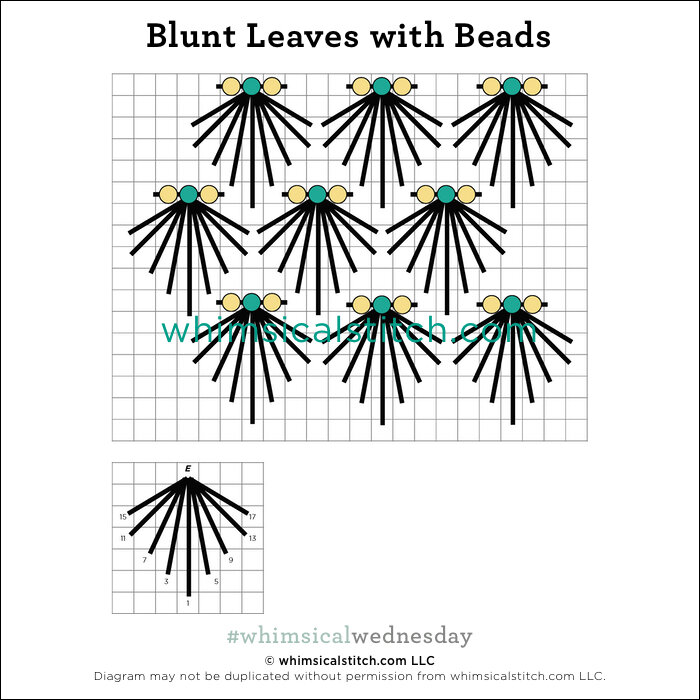Today’s stitch has lots of beads and makes me smile. It also happens to be from one of my favorite projects and stitcher/designers, Plum Stitchery. It’s one of the adorable ornaments from Twelvetide. It makes me smile…a lot.
The stitched sample is two plies of white Needlepoint Inc. Silk (black lines) and white and blue Sundance beads (yellow and blue circles, respectively) with clear beading thread on 18M.
My learned advice on this stitch, and with all leaf stitches in general, is to stitch them from the outer edge to the shared hole. This will reduce wear and tear on the threads and make the process so much easier. In addition, stitch the mirrored stitches sequentially (from side to side) so the layering matches on both sides. (See sequence in the lower left-hand corner of the diagram).
This is rapidly becoming my new go-to stitch for trees and birds. More often than not, I use silk flosses (solid or overdyed), as that helps me manage the potential heaviness of the stitch. As I mentioned, the stitched sample on 18M uses two plies; I would use a minimum of three plies on 13M. If you want a more dramatic look (read heavier), consider a single strand Perle cotton, Elegance, Grandeur, or Trebizond Silk. If you want to minimize the bead, feel free to use a single bead. In that case, I would use a bead slightly larger than the canvas typically calls for. Specifically, I would use a size 11 bead on 18M and a size 8 bead on a 13M canvas. If you want to add more sass, consider an appropriately sized bugle bead or even add a Boho bead to the mix.
This stitch diagram, along with all other #whimsicalwednesday and #smallspacesunday stitch diagrams, can also be found on a Pinterest board here.
Be sure to follow whimsicalstitch.com on Facebook, Pinterest, Instagram, and Twitter.
If you like what you see on this blog, want to learn some very creative decorative stitches, and how to put them all together, whimsicalstitch.com has a book for you! Mary’s Whimsical Stitches is a contemporary how-to collection of more than 250 stitches for stitchers regardless of skill level. The book includes updated and sequenced diagrams from this blog, all-new stitches, and a chapter on the basics of needlepoint. For more information, visit here.
whimsicalstitch.com also sells Stitch Guides and Stitch Concepts for Melissa Shirley Designs, Zecca Designs, Sandra Gilmore, Purple Palm, Maggie, and Penny MacLeod, and many more. Click here to see the newest guides and click here to see the entire collection.
I hope you have the perfect spot for this stitch! Please enjoy! Have a wonderful #whimsicalwednesday!
A Note about Diagrams
I use color in diagrams to make them as clear as possible. The primary function of different colored lines is to illustrate a stitch sequence. For example, the layering of colors demonstrates you add them in that order. They can also provide ideas on how to integrate additional threads (one line for each color). Or, you can use the same thread for all color lines. That's where I encourage you to use your imagination for the space you are stitching!



